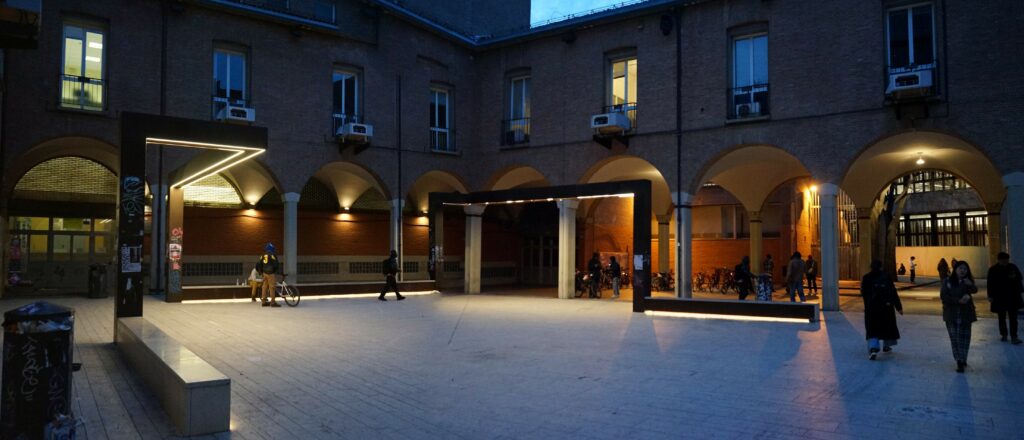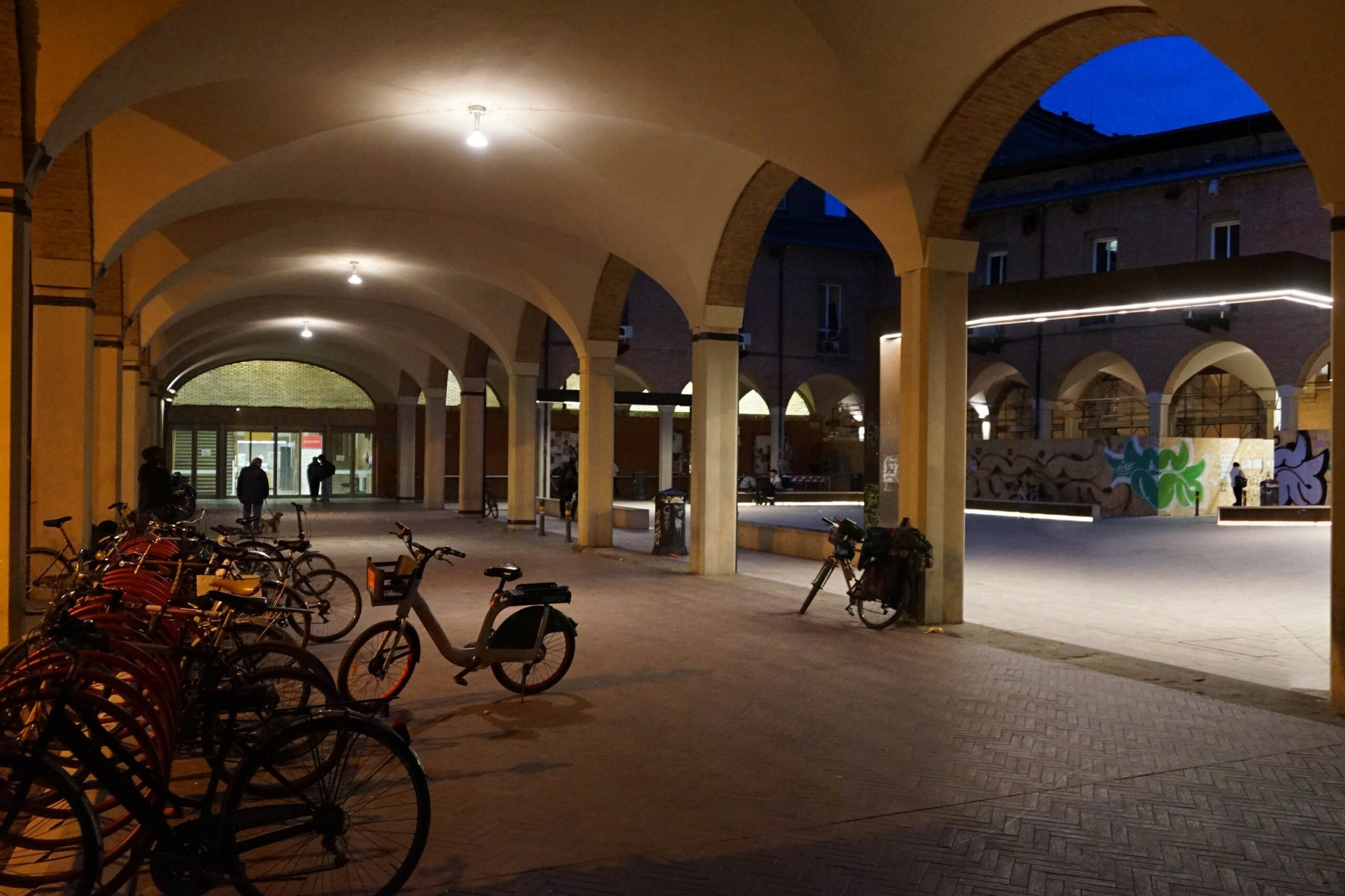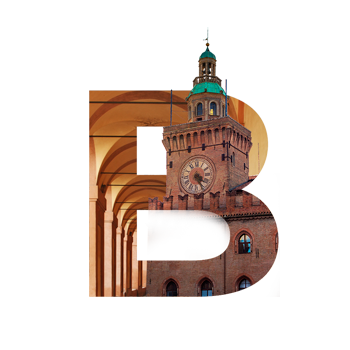
Scaravilli Square
Bologna
Italy
Piazza Scaravilli is a central and symbolically rich space within Bologna’s university district, located between Via Zamboni and Via Belle Arti, just in front of the main entrance of Palazzo Poggi, the headquarter of the University Rectorate.
More on Scaravilli Square
The square, now defined by its four-sided portico, has undergone a series of historical transformations that reflect the evolving identity of both the University of Bologna and the city itself.
The roots of the site date back to 1711, when geographer and scientist Luigi Ferdinando Marsili established the Institute of Sciences in a 16th-century building formerly owned by Cardinal Poggi. Marsili envisioned a multidisciplinary centre dedicated to scientific advancement—housing military architecture, geography, urban planning, and astronomy. At the heart of this vision was the construction of the Specola, an astronomical observatory tower located in what was then a darkened area of Bologna, ideal for celestial observation. This connection to light and darkness ties the space intrinsically to the themes explored in the Art of Darkness project. The Specola, now part of Palazzo Poggi, remains a symbolic landmark of the university.
The Napoleonic reforms of the early 19th century brought sweeping changes to Bologna’s academic landscape. In 1802, the Archiginnasio was sold, and teaching activities were consolidated around Marsili’s Institute of Sciences, giving rise to the modern Napoleonic University. This shift also marked the beginning of a close institutional relationship with the newly established Academy of Fine Arts, reinforcing the area as a key cultural and educational hub.
Urban planning visions for the square emerged in the late 19th century, notably through engineer Raffaele Cappellini’s 1888 proposal for a civic campus modelled after Piazza Verdi. However, the transformation of the area only gained momentum in the 1930s, when large portions of the medieval neighbourhoods of San Giacomo and Sant’Apollonia were demolished under Fascist-era urban modernization campaigns. The resulting architecture, completed between the 1950s and 1970s by architects such as Luigi Vignali, Enea Trenti, and Enzo Zacchiroli, sought to blend modern design with the historical urban fabric. Key buildings include the Department of Economics and the Walter Bigiavi Library.
The naming of Piazza Scaravilli commemorates Antonino Scaravilli, a law student and partisan who was killed during the war of liberation. His legacy, and that of other students who resisted Fascist forces, endows the square with profound symbolic significance for the university community.
For much of the late 20th century, the square served as a parking lot and a space of transit rather than congregation. However, its role shifted dramatically following a major revitalization initiative under the EU-funded ROCK project in 2017. Today, Piazza Scaravilli functions as a vibrant public space, hosting graduation ceremonies and cultural events, and serving as a focal point for student life. Its latest transformation completes a historical arc spanning over three centuries, reaffirming the square’s place as a dynamic intersection of memory, learning, and urban identity.
Pilot Site goal

The Art of Darkness project seeks to engage with Piazza Scaravilli not only as a physical site, but as a layered urban palimpsest shaped by history, memory, and transformation.
Through artistic research, site-specific installations, and critical reflections on light, shadow, and collective space, the project will activate the piazza as both stage and subject.
By working within this historically resonant square—once a site of observation, resistance, and reinvention—Art of Darkness aims to explore how contemporary creative practices can reveal, question, and reshape the ways we inhabit and perceive the public realm.
Read More
The aim of the piloting is to develop Piazza Scaravilli to a more inclusive, safer and more liveable city environment, respecting the aesthetic and cultural values of the site.
The pilot aims to make active night life more socially sustainable by reducing conflicts and unsafety during night in the area, which is a priority for the University and the city. The University wants to invest to the square in order to make it attractive and lively, contrasting the phenomena of crime and degradation that are frequent in the area. The change in the use of these spaces can improve the liveability and security of the entire area by stimulating different attitudes of using and sharing these spaces among students and residents.
The proposed pilots would also be consistent with another project of the University: UFO (which in Italian is the acronym for Università Fuori Orario – University after closing time). The aim is to open at night some buildings in this area where to organize events, cinema projections, debates, lectures, and laboratories.
The University is interested in developing video mapping and adaptive lighting systems in Piazza Scaravilli, taking advantage of the projectors system already in place. UNIBO will co-design with the students and the citizens one or more video mapping to animate the evenings and nights in the city center. The design of the square could be enriched by furniture to allow different uses that could be decided during workshops with the students and the citizens. Baricentro’s green area will be equipped with tables and benches, as sort of open-air study room, to make it a lively area, introducing uses and activities that can guarantee the presence of young people also late in the night.
Local stakeholders and networks
The University has strong connections and collaboration with the students’ associations and good relationships with local residents’ associations and the city of Bologna. The local CCI sector can be easily involved but there is also the interest to open up to international panorama.
Beyond citizens, young people in general, students that could be involved in co-design workshops to define the layout of the public spaces, the lighting systems and the activities and uses of the area, other interesting stakeholders are Museo della Specola (university museum just in front of Piazza Sacravilli active in the field of astrophysics), astrophysics and Space Science Observatory of Bologna, and Cielo Buio, an Italian association supporting actions aimed at correctly combat the phenomenon of light pollution.
Partner involved
- University of Bologna
